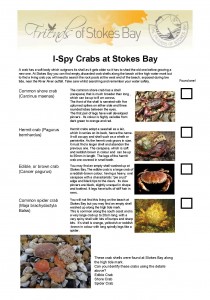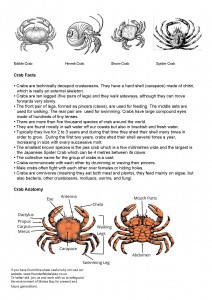At Stokes Bay you can find empty, discarded crab shells along the beach at the high water mark but to find a living crab you will need to search the rock pools at the west end of the beach, exposed during low tide, near the River Alver outfall.
Take care whilst searching and remember your water safety.
| Common shore crab (Carcinus maenas) The common shore crab has a shell (carapace) that is much broader than long , which can be up to 8 cm across. The front of the shell is serrated with five upturned spikes on either side and three rounded lobes between the eyes. The first pair of legs (pereopods) have well developed pincers (chelae). Its colour is highly variable from dark green to orange and red. The different colours are related to its age. Males have a triangular abdomen, while in females, the abdomen is rounded and of equal breadth for most of its length. You can sometime see a female carrying its eggs, an orange mass, on its underside Variation in colour may be due to the stage of the life cycle or the habitat. Young shore crabs display a wide range of mottled patterns. https://www.marlin.ac.uk/species/detail/1497 |
||
| Hermit crab (Pagurus bernhardus) Hermit crabs adopt a seashell as a lair, which it carries on its back, hence the name. It will occupy and shell such as a whelk or periwinkle. As the hermit crab grows in size, it must find a larger shell and abandon the previous one. The carapace, which is soft and reddish brown in colour and can be up to 35mm in length. The legs of the hermit crab are covered in small teeth. The large right claw is used for defense, and the smaller left claw for scooping food and water. https://www.marlin.ac.uk/species/detail/1169 |
|
|
| Edible, or brown crab (Cancer pagurus) The edible crab is a large crab of a reddish-brown colour, having a heavy, oval carapace with a characteristic “pie crust” edge and black tips to the claws. A mature adult may have a carapace width up to 25 cm (10 in) and weigh up to 3 kg (6.6 lb). Its claw pincers are black, slightly unequal in shape and toothed. It legs have tufts of stiff hair in rows. The last segments of its walking legs havespin-like tips. Males are typically 60 mm in length whilst females can be 98mm in length. Cooked for food, male edible crabs are referred to as cocks and females as hens. You may find an empty shell washed up at Stokes Bay. https://www.marlin.ac.uk/species/detail/1179 |
||
| Common spider crab (Maja brachydactyla Balss) You will not find this living on the beach at Stokes Bay but you may find an empty shell washed up along the high tide mark. This is common along the south coast and is a very large crab up to 20cm long, with a very spiny shell with lots of bumps and sharp bits. It is orange, yellowish or reddish-brown in colour with long spindly legs like a spider. The legs are covered by hairs. The first pair of legs bear small claws while the rest taper to stout, dark tips. https://www.marlin.ac.uk/species/detail/2225 |
 |
The next time you are going to visit Stokes Bay Beach download, print and take this handy guide with you. See if you can find an example of each. Great fun for the children, and adults! Download as PDF file I-Spy Crabs on Stokes Bay Beach If you find an interesting or unusual crab or crab shell we would like to see a photo!More Crab Information BeachStuff Crabs |
 |